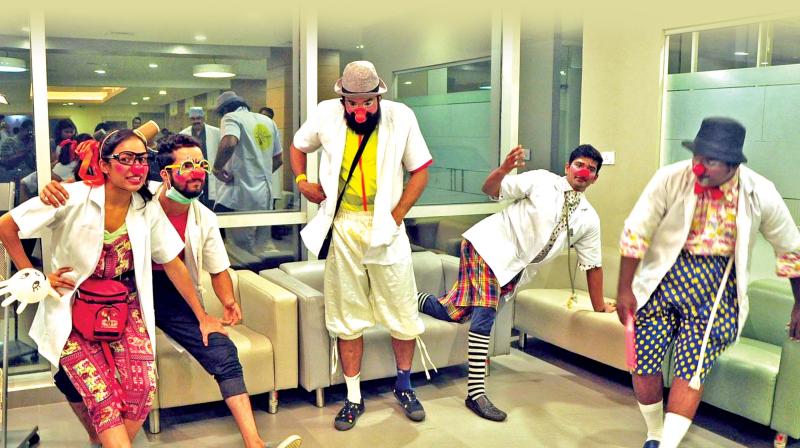Incredibly Healarious!

It’s a very unusual sight at a hospital, at least in Kerala. A grownup man, sporting a red, squeaking nose, in mishmash dress and a lab coat over it, blows bubbles, as another, with painted face, holds a balloon, jumping and swallowing those. Beside them are three more clowns, hopping, falling and hitting the wall as they run around. One of them rushes towards an amused girl who giggles at their antics and introduces themselves, “Hello, I am Dr Happy and these are Sister Lolakutty and Unnikkuttan.” Suddenly, Lolakutty lets out a squeal, “Oh no, I know you. You are Trisha!” And Unnikkuttan joins, “I know her sister. Her name is Samantha.” And they jump up and down, as more onlookers stare at them, in surprise and amusement..
These five clowns of The Little Theatre’s Hospital Clown troupe flew down from Chennai as part of their healing therapy for young patients at Aster Medcity, Kochi, recently. And this was the first time a hospital in Kerala witnessed hospital clowning.
Ask them since when have they been performing as clowns; they burst into laughter, “We were born clowns. We are a family.”
The five, led by Dr Happy aka Krishnakumar Balasubramanian, artistic director of The Little Theatre, are part of the 12-member Hospital Clowns troupe – the first in the country, which has been engaged in an outreach programme spreading positivity at government hospitals in Chennai since 2015.
While Krishnakumar, Shabeer Kallarakal, Vikas Rao and Egypth Dinesh are professional actors, Rohini Rau is a medical doctor.
Explaining the evolution of the troupe, Rohini says, “It started with my mother Aisha Rau, who has been running The Little Theatre, the first non-profit theatre group for children, for more than 25 years. Sometime back, she came up with the idea of merging theatre and healthcare. While doing an online course on reality workshop for children, she acquainted Hilary Chaplain, a New York-based master trainer in hospital clowning. A noted professional physical comedienne in the US, she trained 14 actors from the theatre and that’s how it all began.”
Being a doctor and daughter of a theatre activist, Rohini had no choice but to happily join the programme that integrates medicine and art.
“Hospital is a place where people don’t laugh. It’s said that children laugh at least 700 times a day and adults, 15 times. In hospitals, it’s zero. Our mission is to spread happiness and help children adapt to surroundings. Fun and laughter distract them from pain and medical procedures. Researches prove that clowning can help reduce the use of sedatives and help patients face treatment with a positive attitude,” says Rohini, who, along with her partner Krishnakumar and the whole team of The Little Theatre, conducts training workshops for children, fund-raisers, scholarship programmes and an annual theatre festival.
Clown care was popularised by American physician Patch Adams who, in the 1970s, used to conduct world tours of volunteers dressed up as clowns to cheer up child patients and orphans. “It’s quite popular in countries like the US, UK and Israel. People here are yet to know about clowning and the healing power of fun,” says Krishnakumar.
“More than entertainment or laughter therapy, clowning involves restoring the patients’ control over themselves in hospital environment. Endorphins released in the body help quicker healing. Through interactions like magic tricks, story-telling, music, dance and funny gestures, we help them deal with pain and stress. Laughter is just a small part of it,” he says.
They all work on their clowning vocabulary and theatrics regularly. Apart from training and improvisation, hospital clowning requires great skill; the clowns have to be as sensitive as they are funny. “Along with artistic ability, empathy and sensitivity are very important. Seeing people suffering is not easy, but we all greet it with positivity,” says Rohini.
Meeting people with different problems and mindset on a regular basis, have they always been able to pull it off? Haven’t people been angry? “Rarely, they do,” says Rohini.
“Sometimes, we cut short and move to another place, sensing the atmosphere. But mostly, they start enjoying when they get used to it and come back to us,” she adds.
A show lasts an hour and a half or more, but the effect lasts- hours, days and sometimes weeks. “They talk about it after we leave. Reliving it all increases the effect,” Rohini points out.
The clown act is a weekly voluntary activity for the troupe; the rest of the days, they are busy with their profession. As Krishnakumar puts it, “This is our best way to give back to society. We are doing this because we care about children – the child in you and me.” And he quickly switches back to Dr Happy-mode, shouting, “Come on nurse, hurry! I have a heart-kidney transplant due. Let’s go!”

